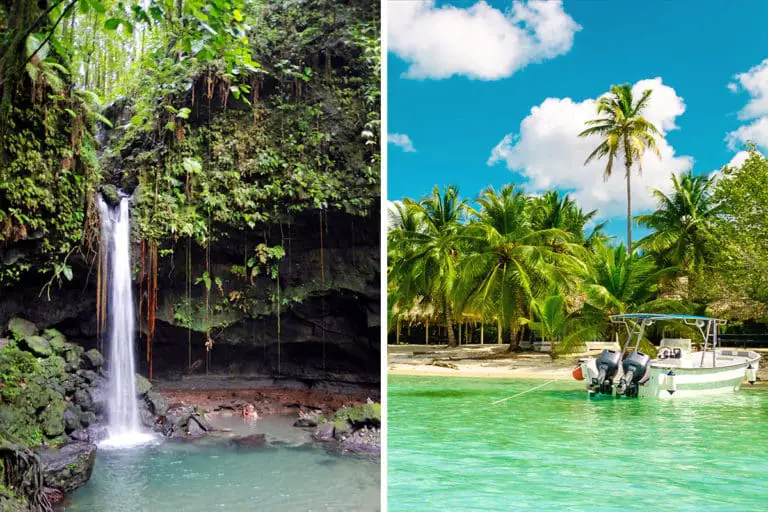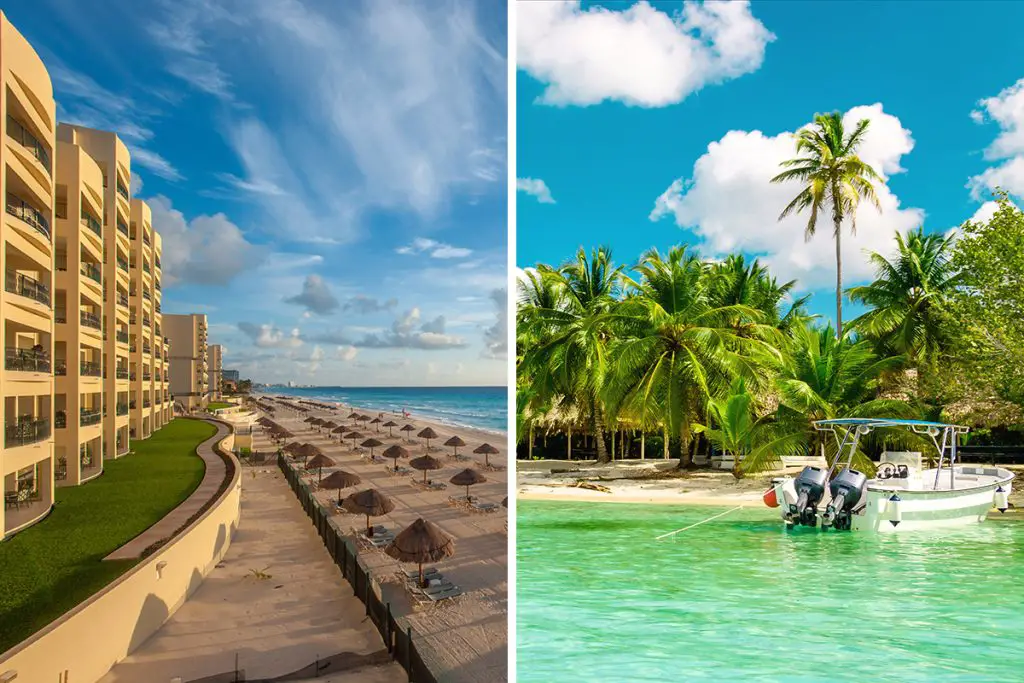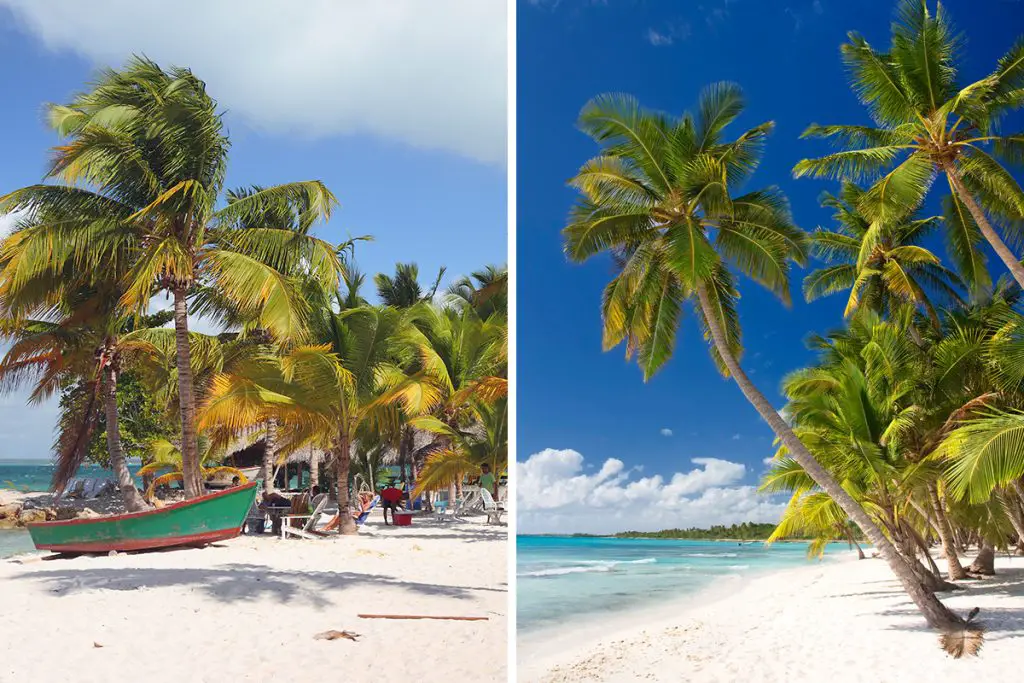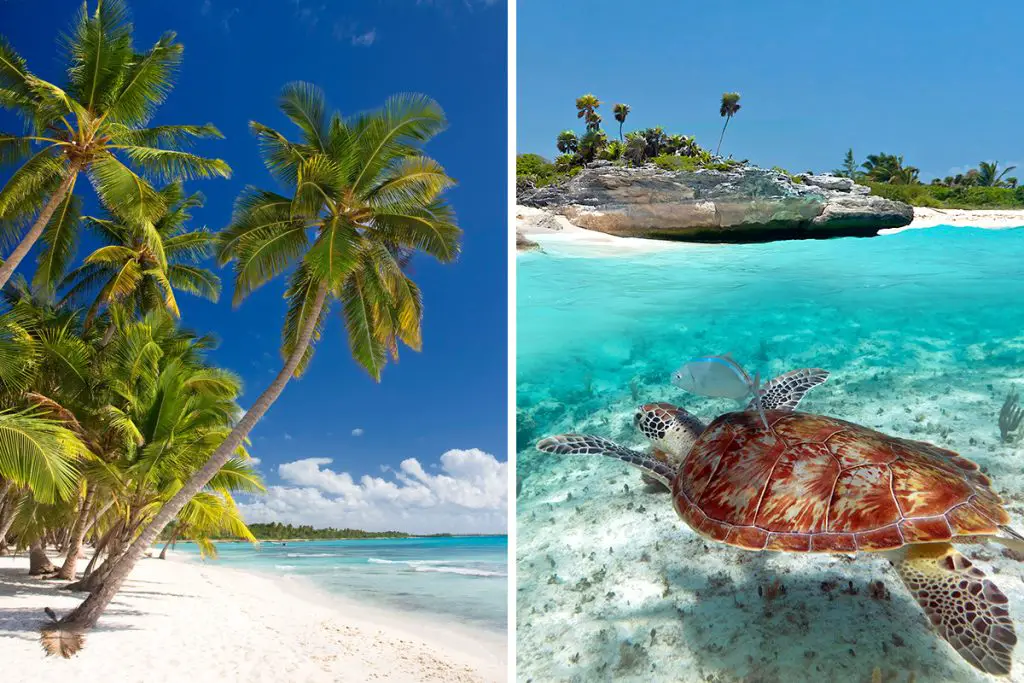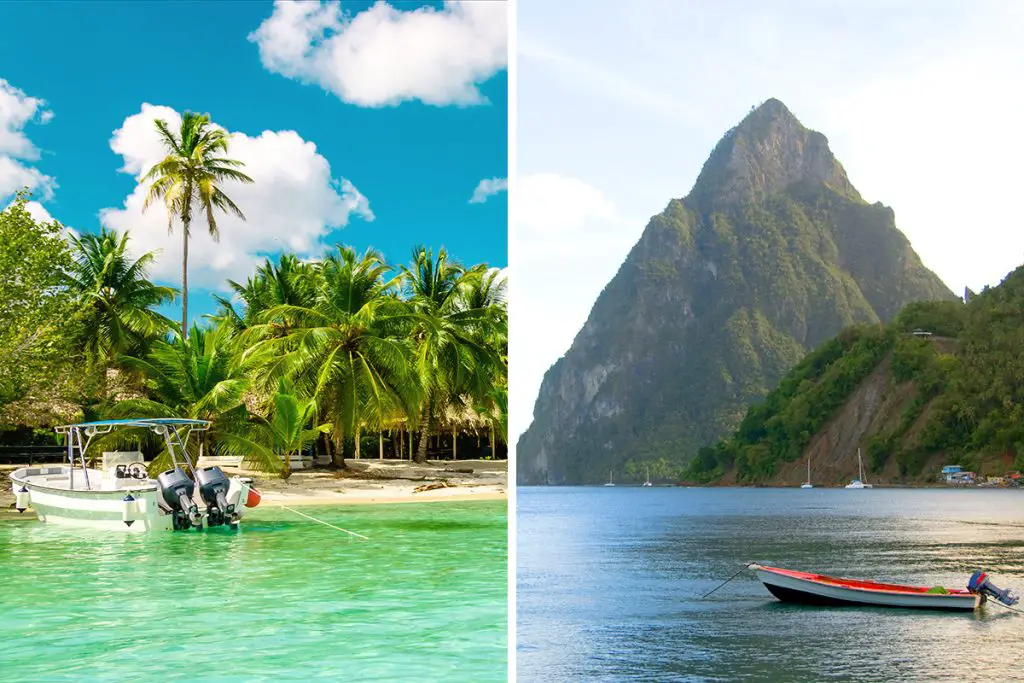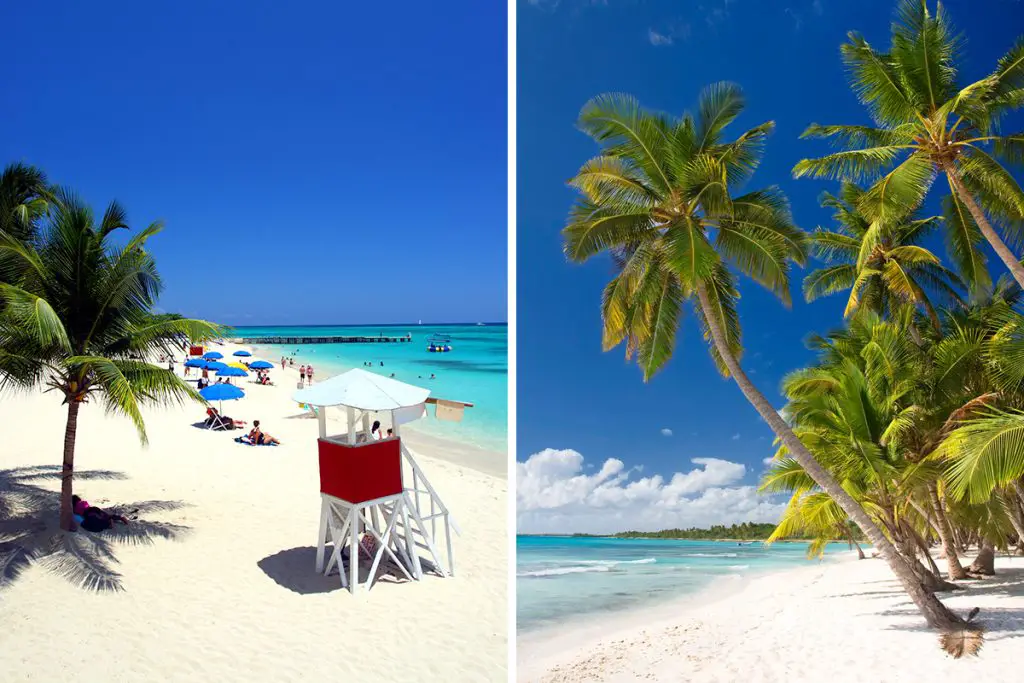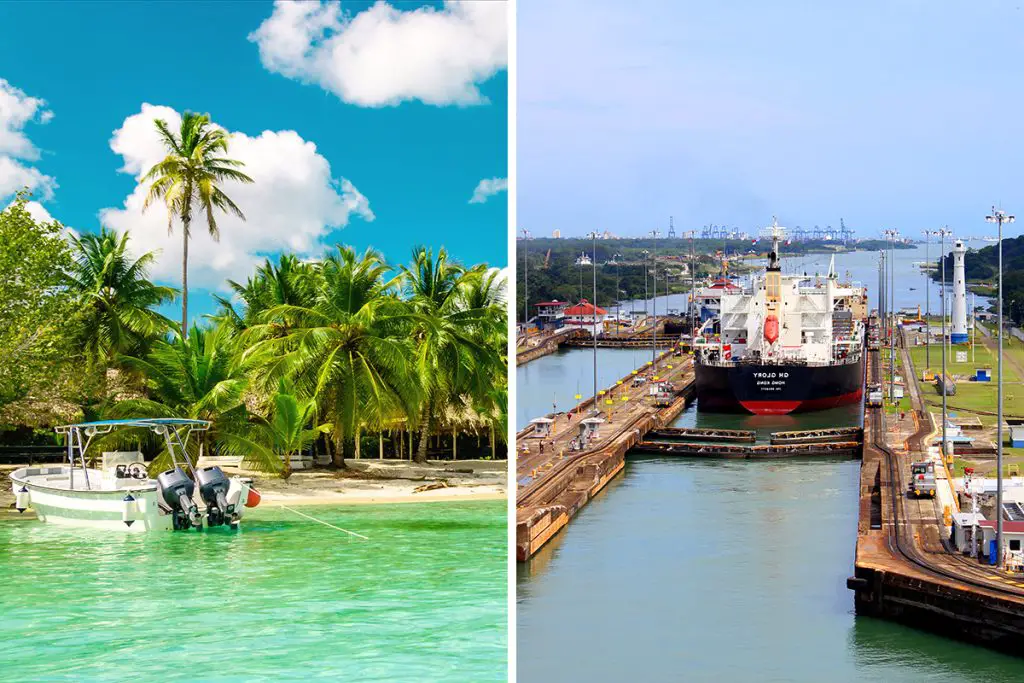One is a large island with many visitors and a well-known name, while the other is off-the-beaten-path, a well-kept secret, and a paradise best reserved for individuals who sincerely respect nature and culture wherever they may be.
Dominica
Ever heard of the Nature Island of the Caribbean? You’re likely thinking that there is no tropical island that doesn’t have some form or fashion of ecotourism. That may be the case but Dominica is truly at the cutting edge of natural beauty, literally being formed by geothermal-volcanic activity at this very moment. It’s also constantly shifting its shape with a vigorous dynamic, its 365 rivers will astound you; all you need to do is explore.
Dominica is pristine in the truest sense of the word because it is the youngest of the Lesser Antilles’ cluster of island-countries, unspoiled by and governmentally protected against the unfettered advances of commercialism. With that in mind, flora and fauna can bloom and prosper for you to observe and encounter them the way they should — out in the open, wild and free.
Smack-dab in the middle of Guadeloupe and Martinique, it’s a perfect midway point in your Caribbean tour. It is even a worthwhile standalone destination if the grandeur of nature-at-its-finest is appealing to you. Still not convinced? Check out Dominica’s selling points below.
What Makes Dominica Unique?
Nature First
Tired of party and beach destinations? Want to find a pristine place and peaceful way to be in touch with the life force of the planet? Nature lovers can’t get enough of Dominica so why shouldn’t you? It isn’t called Nature Island for the heck of it.
Dominica’s national parks are its crowning glory. The local government has put its country’s natural resources at the forefront of its economic drive, thereby developing protection and conservation efforts to make them shine innately without much need for heavy modernization efforts; it makes for the most authentic take of what the place has to offer.
With all its rugged terrain, bodies of water, and luxuriant vegetation, it’s quite easy to get paralyzed from indecision — deciding what to do first or what can fit in your schedule can be a challenge. To help with that, examine the list below of the ‘prominent’ spots on the island-country.
Cabrits National Park
Figuring out how to be a daredevil without much of the associated danger? Try an extinct volcano, just don’t mention the extinct part. Brag about your accomplishment of conquering a volcano to your friends and family, they’ll be none the wiser. This unique place jutting into the Caribbean is located at the north end of this grand island, a walkable (to some) few miles north of the town of Portsmouth.
With this national park being a volcano, it’s a given that the land surrounding it is fertile, hence the abundance of forests, wetlands, and coral reefs in its vicinity suited for exploration by wide-eyed wanderers.
If you’re one to take things easy, consider the less taxing hikes on its well-maintained west and east trails. However, if you are concerned about the lack of natural shade, the younger and elderly hiking crowd may want to opt out.
The terrain is quite a strategic vantage point of the area that the British and French military had eventually developed a military outpost to further their expansionist goals. The fort’s ruins, aka The Cabrits Garrison, have some sections restored to their former Georgian architectural splendor, while some remain in disrepair. Collectively, they are quite the attraction in themselves — a type of outdoor museum, if you will.
Enjoy the most impressive panorama towards Prince Rupert Bay on the ramparts lined with all manner of artillery — mortars, cannons, carronades — a historical-weapon-monger’s fantasy land they’d drool over.
Boiling Lake
The world’s largest boiling lake sounds too hot to handle because it is. A few miles east of the capital city, Roseau, and landlocked in Morne Trois Pitons National Park, Boiling Lake is one of the many dramatic sights to behold. Even the name of the valley that it is in hypes up the intensity of the place … The Valley of Desolation.
You may not swim in the lake but you sure can hike going to its banks. It is not for the faint of heart, though; it is a demanding undertaking. Don’t be disheartened, nevertheless. Hire a guide so you can survive [exaggerating] the unforgiving 3-hour trail, not so much physically but with the information dump as well.
Reach the finish line and be treated to a sight akin to steaming saunas over hot rocks, or perhaps one of those hot spring pools. Too bad you can’t rest yourself in the boiling water … you’ll just have to settle for the modest ones along the hike. Although, how will you know which site is dangerous? This is where the experienced guide is truly invaluable.
Emerald Pool
Looking for a UNESCO site? Look no further! It is easily one of the most accessible attractions to get to, just 10 minutes off Roseau–Castle Bruce Road.
This attraction has a 40 ft (12 m) waterfall feeding the pool whose emerald green reflects the lush and verdant surroundings. It is perfect for a dip designed for relaxation and rejuvenation, and the peculiar color makes for a wonderful backdrop to any photo shoot.
The fact that it is an easy trail to the pool makes the journey child-friendly. The site itself is nowhere near as extreme as other nature treks in Dominica. You’ll not have to leave anyone behind on this excursion, guaranteed.
Festivals Galore
With its moniker, Nature Island of the Caribbean, if you think that the only thing you can do here is to just laze away, basking in the marvelous sights or challenge yourself in the remarkable hikes, think again. There is more to this island nation than just its naturistic drive; it has its fair share of festivities, something very omnipresent in Caribbean nations and similar destinations.
To give you an idea of what to expect and when you should capitalize on them, look no further. Here are a few to consider in your destination investigation.
DOMFESTA or Dominica Festival of the Arts
April to June each year sparks the months that cater to all the creative artistry of the locals and the fans of such cultural expression. Whether it be dance, music, art, drama, and any other creative talent, they can and will be showcased here.
This place also serves as a venue for folk arts and their corresponding artists to strut their stuff and hang with the contemporary art scene. The event assists to bring age-old creative cultural representation to the forefront of Dominica and the world stage.
Nurture your budding talent in the workshops and seminars for your choice of creative endeavor. Or just simply appreciate the depth and breadth of Dominica’s culture and love for the arts, and ultimately be inspired to rouse your dormant talent.
Dive Fest
You’ll be branded as a not-so-serious scuba-diving enthusiast if you miss the Dominica Dive Fest. The Dominica Watersports Association’s educators will find some way to convince you that scuba and its associated activities are valid career paths and avenues for a revenue, not just some money-sinking pastime. But even if you’re not into scuba, there are water-based activities and educational tours that should pique your interest.
Watch out every July for some sick aquatic stunts and competitions that highlight Dominica’s exquisite marine environment — with a traditional touch. Whale-watch, try out all-inclusive dive packages, join in on underwater treasure hunts, have a BBQ picnic right by a snorkeling spot, participate in marine educational tours, and canoe race the traditional way — on a wooden canoe in the Kubuli Carib-Canoe Race.
A Dive Fest to be undertaken over the course of 10 days or so, in no particular order or grouping, would contain the following:
- Happy hour with a DJ and giveaways,
- Discover Scuba Diving for the kiddies,
- Beginner’s Dive,
- Clean Up Dive for the more advanced and certified divers out there,
- and Beach Clean Up with some games
Note: the events in the schedule are quite variable; certain years had more gathering and meet-and-greet-type settings, plus the Kubuli Carib-Canoe Race.
To wrap the festivities up, the Kubuli Canoe Race in Soufriere is an intense and competitive scene. Go there as a spectator because you won’t regret it even if you are not a fan — there is a beach party afterward, so party hard.
Nature Island Literary Festival & Book Fair
This event may not be explicitly in alignment with the ecotourism theme of the country, but it definitely showcases the country’s national and regional writing prowess. Writers from all over the globe can’t help but share their literary masterpieces in this August activity held at the UWI Open Campus on Elmshall Road, Roseau.
Listen to readings, attend or conduct an open mic session, sign up for a workshop, do a book exchange, and score that elusive book not even Amazon could deliver [if that’s even possible]. There are even children’s events for the youngsters still working on their reading and writing skills. What makes it even better is that all events are practically free! It’s the perfect place to pick up a book for your next lounge session by the beach.
Rich Mixed History
Here’s what you don’t know about Dominica’s history that’ll blow your mind: it does not share the same timeline of colonization as most of the Caribbean nations. Other nations were straight-up colonized upon or shortly after being discovered by Christopher Columbus, like, say, Puerto Rico. It could be argued that the 1493 Spanish empire did not find enough reason to make their claims, apparently, the lack of gold helped with that.
Nowadays, you’ll definitely feel the mix of influences that have forever defined and continue to evolve the culture of Dominica. It is a synthesis of Carib, French, African, and British cultures. You’re probably wondering why there is an insert of African all of a sudden. Well, the slave trade was well underway when the French had gripped the nation.
Because of the number of cultural inspirations of Dominica, you can expect them to be very much reflected and interwoven in the different aspects of the people’s daily life and celebrations of which. Customs, values, language, music, art, architecture, government, and religion, among others, have all been touched in a way. Such an atmosphere will make you feel at home in this home away from home.
But what’s truly important with all this knowledge is that you experience these things firsthand. Listen to the Caribbean beat in the musical genre represented by reggae and calypso. Enjoy mainstay Caribbean festivals like Carnival. Be in awe at the vibrant fabrics of traditionally styled Creole or West African clothing. Savor the cuisine not so distant from Caribbean, French, and British classics — sporting a twist. And so much more.
Surprisingly English
What’s an unbelievably easy way to get around Dominica? Speak with the locals and secure yourself some juicy tips and sweet deals.
The historical and cultural foundation of Dominica, assisted by their colonialization and subsequent introduction to the now major world languages, has paved the way for it to be a powerhouse tourist draw.
Having English as the official language, an English-speaking traveler such as yourself will find navigating the locals and locales not as tough as in places without much English, like in most East Asian destinations.
With language barriers and miscommunications out of the way, you need not feel any trepidation, rather, you can focus on deciding what to do first from the endless selection of entertainment and activities to be had in the natural wonderland that is Dominica.
Dominican Republic
The Dominican Republic is truly a blessed land that you must not miss. Its rich environments and varied climates sing songs of diverse adventures just waiting to be experienced — from the alpine forests blanketed with chilling temps in Constanza to the sweltering shifting sands in the Dunes of Baní. But if those are too extreme for your taste, there are always the tropical getaways circumscribing the country, chock-full of the pleasant ambiance you know and love.
But DR’s not just about the natural world it so impressively puts forth, its people is what brings out the country’s character. Culture, tradition, cuisine, and hospitality are but some of what will make you want to keep going back for more.
The Dominican Republic is worth staying at for the whole of your vacation — there is just too much to see and do; with DR being part of the penultimate Caribbean island there is in terms of sheer land area, it should be easy to see why. In any case, go over the tidbits below that could very well help you over the hump if you are stumped about what to expect in DR.
What Makes the Dominican Republic Unique?
Ridiculously Gorgeous Beaches
DR is one of those Caribbean wonders that have the opportunity to play with two bodies of water — the Caribbean Sea and the Atlantic Ocean. This makes for a level of variation in terms of beach environments. The side towards the Caribbean provides a level of calm waters year-round, enabling some of the slower-paced activities, however, the Atlantic side brings rougher waters depending on the season, ideal for water sports enthusiasts.
With over 200 beaches lined along a 1,600-kilometer (1,000-mile) combined Caribbean and Atlantic coastline, how would you even know where to start? Easy, start here:
Playa Grande
Ride by the coast, and after roughly 63 miles (100 km) east from Puerto Plata city, Playa Grande’s golden sands and turquoise waters await. With the beach facing the Atlantic, its swells are naturally good for surfing and similar water sports. In the winter, though, anyone looking for some water adventures needs to seek the advice of local experts to stay safe.
Further inshore, a wall of dense green greets you. Take a few steps towards that for your refreshment and sustenance; music and food are available amongst the shade of the vegetation, quite easily within your reach. Take a snap without the worry of unintended photobombers, the setup of structures is unobtrusive and will work well with your deserted-island photoshoot goals.
Bávaro Beach
This beach is virtually synonymous with Punta Cana resorts that line its long and continuous stretch of sand. It is one of those DR beaches that has been enriched with resort development — that sweet real estate is too good to pass up. Nevertheless, it still maintains its natural flair — turquoise waters and a white-sand beach dotted with lanky palm trees.
Its calm waters provide for less physically demanding activities such as parasailing, speedboating, or catamaran sailing. A simple walk or jog along its length is one way to get a sense of the vast span of the beach; it is, after all, one of the Caribbean’s longest beaches.
Playa Rincón
The Samana Peninsula houses one of DR’s most beautiful beaches in what could be jokily described as the peninsula’s crotch, nestled in the Bay of Rincón. From the municipal district of Las Galeras, a ride of less than half an hour is to be expected before reaching this gem.
Expect to see the bay in all its white-sand, turquoise-water glory, flanked on both sides by the two of the outermost tips of the peninsula. The background is filled with tropical greenery and a smattering of coconut trees in the foreground. It also does not have the level of resort development like the other beaches, perfect for that sweet and serene escape.
With its 3 miles (5 km) of sandy shore, there is enough space to undertake some varied activities. Swim, snorkel, or sunbathe on one side where the waters are calm. On the northern side, bodysurf your way out of rolling waves; it has been a recommendation by some. Then there’s the handful of seafront restaurants ready to take your order of fresh-caught seafood.
Palmilla
Try a secluded and undeveloped beach facing the Caribbean Sea and get access to a shallow natural pool across a large area, which is practically its most endearing quality. It’s just the thing for light recreation and simply chilling. Snorkel here to spot some starfish and other shallow-water marine life. Or lounge in your sea vessel or on the shore while blasting some tunes and scoping the surroundings.
To get here, you’ll need to spend a little extra; it is secluded after all. Rent boats from the nearby resort town Bayahíbe or the city of La Romana. If you have a little more cheddar, take a catamaran or speedboat like a boss. Or if impromptu spending is not something you are fond of, book tours that include a quick stop here — it makes the most sense for a thrift approach.
Quirky Geography
Are you still doing beaches? You might overlook the not-so-hidden wonders DR has to offer. The Dominican Republic is more than your average beach destination, it has geographical features that hang with the best the Caribbean has to offer, it has tropical, alpine, semi-arid, and desert regions.
How is such diversity even possible, you ask? Put plainly, the land is blessed with favorable elevations and trade winds such that peculiar climates form in their “destined” locations. You can even go as far as saying that there is a climate and environment for everyone, that is, if you know where to look.
Still not convinced of how DR can be geographically varied? Check out a few of the following interesting spots:
Los Pozos de Romeo
This is one of DR’s quirky sites that could somehow challenge the cenotes in Mexico, for example. These pools were likely formed under the same geological conditions as open-air cenotes.
The site contains wells of varying depths that shine different shades of turquoise under the glistening sun. Jump into the deep wells or wade in the shallow pools, whatever floats your boat for a cool and relaxing time.
The attraction is readily accessible from the highway south of Pedernales city, so placing it in your itinerary makes logical sense. And best of all, Playa Cabo Rojo’s sands is just a stone’s throw away. It’s a veritable two-for-one.
27 Waterfalls of Damajagua
If you have no fear of heights, this should be worth your while. A short drive from Puerto Plata city, moving inland from the north coast, you will reach the start of the hike towards this chain of 27 waterfalls carved from the never-ending flow of water. It is truly an adventure that you cannot pass up.
Hike up to the start of the cascading falls escapade and jump off cliffs or slide the slippery slopes; it’s a sure-fire fun-filled, exhilarating activity.
Experienced tour guides will provide your safety gear and your well-earned Dominican Lunch, all you have to do is enjoy and complete the challenge of conquering all twenty-seven cascades, like a boss.
Sand Dunes of Bani
In the Las Calderas Peninsula, facing the Caribbean, the dunes made of quartz and feldspar await the eager wanderer. You need not fear the sands; the beach, the bay, and civilization are not far off. You could probably describe it as a kind of massive beach extension, of the sort.
But don’t let your guard down in this place, you could very well get dehydrated if your run up and down the dunes carelessly, it is quite the workout! Get on top of the tallest of dunes and be rewarded with sweeping views of the Caribbean to the south and the bay, Bahia de Las Calderas, to the north.
Flavorful Gastronomy
The Caribbean is filled with the wonder of integrated cultures. And there’s no better way that this is represented and experienced than culinary delicacies fit for sensitive palates.
Over the centuries, a wealth of flavors and techniques were amassed from indigenous Taíno, Middle-Eastern, African, and Spanish cultures, which ultimately lead to its current yet ever-evolving form of cuisine — always taking in inspiration from a wave of new sources.
For the best in DR’s classics, get a load of these tasty treats and refreshing drinks:
Sancocho de Siete Carnes
All you need to get hyped by this dish is in the name — Siete Carnes, or Seven Meats. It’s the ultimate meat lover’s stew in DR. What’s the magic seven, you’re wondering. They’re beef cuts, goat, chicken, pork sausage, pork cuts, pork ribs, and smoked ham bones.
Of course, the order of stewing is important and depends on the locality’s recipe. At around the end of the process, the stew is rounded off with veggies and root crops.
Tostones
Plantain slices fried not once but twice are common in the Caribbean due to the ubiquity of this tropical and starchy relative of the banana. It is a lovely appetizer or accompaniment to your main dish, or just a straight-up snack while lounging at your favorite beach. Don’t forget to savor it with the locale’s special dips to get the utmost flavor.
Guarapo de Piña
The ultimate in tropical refreshment from no less than the Taíno people, this here drink leaves nothing to waste — pineapple rinds and skin are fermented over the course of several days to give you a wonderful meld of alcoholic stupor and phytochemical-induced health.
Have a swig of this healthy concoction after your hearty DR meal to aid in your digestion and give you a mild hit of alcohol. You’ll be glad you did.
The Dominican People
In the Dominican Republic, the citizens put hospitality at the forefront. Their family values provide a solid foundation and authenticity which they use as a basis to treat their fellow man inside or outside the scope of their household.
You can expect to feel very welcome and comfortable, not just in resorts and hotels but even in their humble homes in the more remote locations. Though you may be a stranger in their abode, that does not stop their friendliness and pleasing demeanor; they have a strong emphasis on trust after all.
The language, though, is officially Spanish, so this can be a caveat you’ll have to work with or around if you really want to mingle and fully immerse with the locals in the most fruitful way; the tourist industry works with English quite well, so there is no pressure to brush up on Española.
Which Is Better – Dominica or Dominican Republic?
Despite being the spitting image of each other’s names, Dominica and the DR are two distinct countries both offering different kinds of experiences and flavors for the eager traveler. One is a big island with big draws and a big name, while the other one is off-the-beaten-path, a well-kept secret, a paradise best reserved for those who truly respect nature and culture, wherever they can find themselves to be.
Dominica, the off-the-beaten-path choice, is a slice of ecotourism heaven smack-dab between the Windward and Leeward Antilles. The tiny island boasts its unspoiled natural features, from beaches, mountains, lakes, and forests, thanks to its relatively lesser-known name, the island remains to be conserved and protected. Dominica remains to be quaint, rugged, and simple, with a certain love for many things around its well-protected nature.
The Dominican Republic, on the other hand, is a place for the well-traveled, those looking to have that legendary R&R. The DR is known for many things, especially with a slew of features that appeals to several types of travelers. If you’re looking for R&R, a good party scene, fun-loving people, or just the right balance between peace and fun, DR is ready to welcome you.
FAQ
Is Dominica the Same as the Dominican Republic?
A spitting image of each other’s names, Dominica isn’t the same as the DR, or are the same, Dominica is a separate island completely sovereign from other bigger powers. The small Antillean Island is ironically known for being one of the Caribbean’s best-kept secrets, one of the region’s last unspoiled riches. Dominica is like a smaller Costa Rica, a very well-conserved green patch in the middle of the sea.
The DR is a larger island, having a larger economy, a sovereign nation in itself, and one of the Caribbean’s biggest names. A well-known and well-loved culture thanks to its sunny reputation, the DR best represents what the typical Caribbean holiday looks like.
Is Dominica Close to Dominican Republic?
Despite both straddling the Greater Antilles, Dominica and the DR sits far from each other across the Caribbean. Dominica is approximately 1,005 km or 624 miles from the Dominican Republic, directly. It will take around an hour to fly in between, which is probably the most cost-effective way to travel.
Where Is Dominica vs. Dominican Republic?
Both situated on different sides of the Caribbean Sea, Dominica sits at the easternmost reaches of the Lesser Antilles, sandwiched north to south by Guadeloupe and Martinique. The Dominican Republic sits on the northern side of the Caribbean, occupying the eastern side of the island of Hispaniola as Haiti’s partner.

